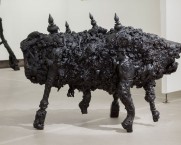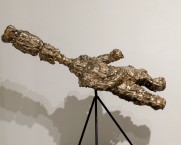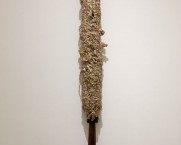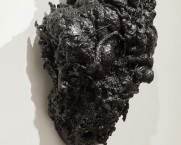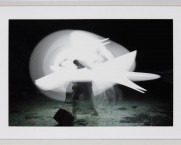C&L Shows
Forerunner
Sahej Rahal
2013
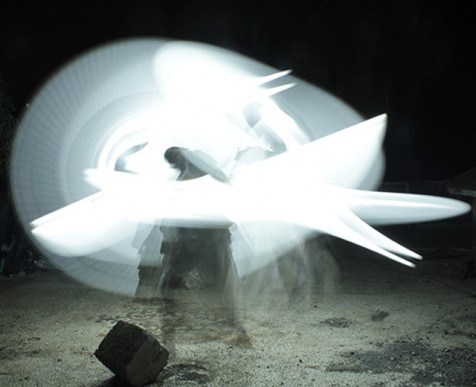
Overview
Sahej Rahal’s artworks revel in masculine fantasy, while also mocking its affectations. The solitary characters he essays seem to have emerged from Joseph Campbell’s Hero with a Thousand Faces refracted through George Lucas’s Star Wars series. The nature of these characters, like that of the peculiar beasts he fashions, is often ambiguous. Is the man wielding a fluorescent tube more like Luke or Anakin Skywalker? Is the wanderer in the subway-labyrinth closer to Theseus or the minotaur? Perhaps he is something in-between: controller of an intermediary domain who might assist in the adventure, should the hero prove his worth by passing a test. While their nature might be indeterminate or protean, these personages all appear like irruptions of a semi-mythic realm into contemporary life.
The artist himself creates costumes and props for his performances, such as the didgeridoo whose ominous drone echoed through a public subway in the course of Bhramana II. A didgeridoo is as male a musical instrument as imaginable, not only for its deep fundamental note, but because certain aboriginal communities forbid women from so much as touching one (It’s another matter that this piece was made from PVC rather than worm-hollowed eucalyptus). The clothes Sahej wore for Bhramana II were as disconcerting as the music he played. He donned an enormous turban, so large that it dwarfed his head and appeared to constrain his ability to see. It seemed the parallel of exaggerated markers of masculinity found in nature, such as the Irish Elk’s antlers: imposing, but also absurd, and potentially counter-productive.
In further explorations, Sahej crafted ornate headgear and weapons from pieces of discarded furniture and household objects, transforming them to resemble precious relics. He is fascinated by the ritualistic, ceremonial dimension of violence, a dimension memorably foregrounded at the end of William Golding’s Lord of the Flies, when the group of British youngsters turned paint-faced warriors confronts a naval officer wearing a huge peaked cap and uniform decorated with epaulettes, gilt buttons and gold foliage. What seems at first glace to be a contrast between primal savagery and sophisticated civilisation soon dissolves into the recognition of a fundamental similarity between what has come to pass on the island and what is taking place in the larger world; the recognition of a continuum that consists of boys’ fun and games at one end and global war at the other.
Sahej’s artistic idol, Joseph Beuys, had an actual experience of war, and converted it into a personal mythology. For all his indebtedness to Beuys, Sahej does not share the German artist’s obsession with natural materials fundamental to life and survival. The fur his shamans wear is fake, and the encrusted sculptures he makes are shaped from polyurethane foam.
Having chosen painting as his major in college, Sahej abandoned it to work in three dimensions, before expanding his practice to performance, into which he incorporated sculpture, and then to video, into which he incorporated both sculpture and performance. He has demonstrated an uncommon aptitude for all aspects of video, usually operating the camera himself even when he appears within the frame, and producing precisely paced edits. His most ambitious effort, Forerunner, which has lent its title to his debut solo show at Chatterjee & Lal gallery, introduces his talent for writing, through a seamless narrative that dovetails passages from Jorge Luis Borges with an imagined account of a Tughlaq-era hunting lodge in Delhi (that, according to some historians, doubled as an observatory), and the story of a sage who mysteriously disappeared from here, giving the site its current name, Pir Ghaib.
The hunter, the explorer, and the mystic: these three extreme forms of being have preoccupied the artist through his short career. He found the three intertwined in the history and legend of Pir Ghaib, and has used the site as a take-off point for a penetrating reflection on history, the universe and everything.
Girish Shahane, 2013



